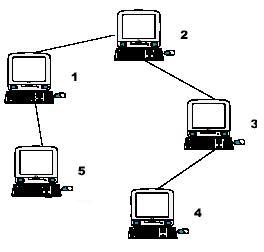[HDU 2196] Computer
Computer
Time Limit: 1000/1000 MS (Java/Others) Memory Limit: 32768/32768 K (Java/Others)
Total Submission(s): 4073 Accepted Submission(s): 2039
Problem Description
A school bought the first computer some time ago(so this computer's id is 1). During the recent years the school bought N-1 new computers. Each new computer was connected to one of settled earlier. Managers of school are anxious about slow functioning of the net and want to know the maximum distance Si for which i-th computer needs to send signal (i.e. length of cable to the most distant computer). You need to provide this information.

Hint: the example input is corresponding to this graph. And from the graph, you can see that the computer 4 is farthest one from 1, so S1 = 3. Computer 4 and 5 are the farthest ones from 2, so S2 = 2. Computer 5 is the farthest one from 3, so S3 = 3. we also get S4 = 4, S5 = 4.

Hint: the example input is corresponding to this graph. And from the graph, you can see that the computer 4 is farthest one from 1, so S1 = 3. Computer 4 and 5 are the farthest ones from 2, so S2 = 2. Computer 5 is the farthest one from 3, so S3 = 3. we also get S4 = 4, S5 = 4.
Input
Input file contains multiple test cases.In each case there is natural number N (N<=10000) in the first line, followed by (N-1) lines with descriptions of computers. i-th line contains two natural numbers - number of computer, to which i-th computer is connected and length of cable used for connection. Total length of cable does not exceed 10^9. Numbers in lines of input are separated by a space.
Output
For each case output N lines. i-th line must contain number Si for i-th computer (1<=i<=N).
Sample Input
5
1 1
2 1
3 1
1 1
Sample Output
3
2
3
4
4
树形DP、带注释
#include <iostream> #include <algorithm> #include <cstdio> #include <queue> #include <cmath> #include <map> #include <vector> #include <iterator> #include <cstring> #include <string> using namespace std; #define max(a,b) ((a)>(b)?(a):(b)) #define min(a,b) ((a)<(b)?(a):(b)) #define INF 0x7fffffff #define ll long long #define N 10010 struct Edge { int to,next,len; }edge[N<<1]; int head[N],tot; int n; int dp[N][3]; //dp[i][0]表示从儿子能走的次大距离 //dp[i][1]表示从儿子能走的最大距离 //dp[i][2]表示从父亲能走的最大距离 template <class T> inline bool input(T &ret) { char c; int sgn; if(c=getchar(),c==EOF) return 0; while(c!='-'&&(c<'0'||c>'9')) c=getchar(); sgn=(c=='-')?-1:1; ret=(c=='-')?0:(c-'0'); while(c=getchar(),c>='0'&&c<='9') ret=ret*10+(c-'0'); ret*=sgn; return 1; } inline void out(int x) { if(x>9) out(x/10); putchar(x%10+'0'); } void init() { tot=0; memset(head,-1,sizeof(head)); memset(dp,0,sizeof(dp)); } void add(int x,int y,int z) { edge[tot].to=y; edge[tot].len=z; edge[tot].next=head[x]; head[x]=tot++; } void dfs1(int u) //从下往上、求出u到子树的最远距离和次远距离 { for(int i=head[u];i!=-1;i=edge[i].next) { int v=edge[i].to; int w=edge[i].len; dfs1(v); if(dp[v][1]+w>=dp[u][1]) { dp[u][0]=dp[u][1]; dp[u][1]=dp[v][1]+w; } else if(dp[v][1]+w>dp[u][0]) { dp[u][0]=dp[v][1]+w; } } } void dfs2(int u) //从上往下、求出从父亲、从儿子走的最长距离 { for(int i=head[u];i!=-1;i=edge[i].next) { int v=edge[i].to; int w=edge[i].len; if(dp[u][1]==dp[v][1]+w) //如果v 在u的最长路上,那么两条路:从父亲U的父亲走,父亲U的最长儿子走 { dp[v][2]=max(dp[u][0],dp[u][2])+w; } else //如果v不在u的最长路上,那么两条路:从父亲U的父亲走,父亲U的次长儿子走 { dp[v][2]=max(dp[u][1],dp[u][2])+w; } dfs2(v); } } int main() { while(input(n)) { init(); for(int i=2;i<=n;i++) { int a,b; input(a); input(b); add(a,i,b); } dfs1(1); dfs2(1); for(int i=1;i<=n;i++) { out(max(dp[i][1],dp[i][2])); //取从儿子和从父亲能走的最大距离 putchar('\n'); } } return 0; }
趁着还有梦想、将AC进行到底~~~by 452181625




